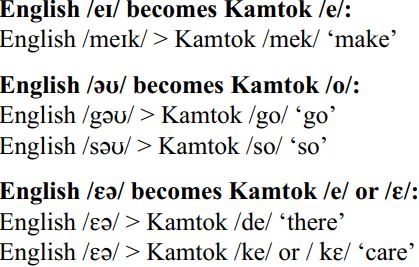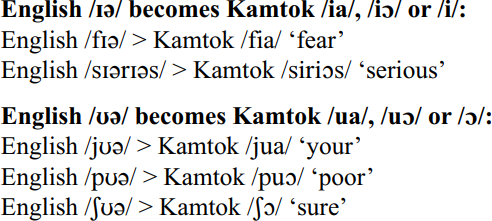


 Grammar
Grammar
 Tenses
Tenses
 Present
Present
 Past
Past
 Future
Future
 Parts Of Speech
Parts Of Speech
 Nouns
Nouns
 Verbs
Verbs
 Adverbs
Adverbs
 Adjectives
Adjectives
 Pronouns
Pronouns
 Pre Position
Pre Position
 Preposition by function
Preposition by function 
 Preposition by construction
Preposition by construction
 Conjunctions
Conjunctions
 Interjections
Interjections
 Grammar Rules
Grammar Rules
 Linguistics
Linguistics
 Semantics
Semantics
 Pragmatics
Pragmatics
 Reading Comprehension
Reading Comprehension|
Read More
Date: 2024-05-08
Date: 2024-04-29
Date: 2024-04-13
|
In the process of building a new system, Kamtok has drastically reduced the number of vowels it uses. Whereas English makes use of a dozen vowels, Kamtok vowels stand at six. This reduction in the number of vowels has been achieved partly through “mergers”.
A merger can occur within a language when, over the years, several sounds gradually become one. A number of similar or closely related English sounds are merged in Kamtok as one sound with which users are more familiar. Such a sound is usually one that is found in both English and most Cameroonian languages or only in the local languages. Some mergers are listed below:

A second aspect of vowel restructuring is a strong tendency to produce simple vowels in the place of certain English diphthongs, with the second element of the diphthong usually being dropped:

The pronoun ‘I’ /aɪ/ is usually produced in Kamtok as /a/.
Other centring diphthongs of English are restructured to produce new sound combinations, which accord with Kamtok phonology:

English triphthongs are restructured through glide formation. This process involves the transformation of the central element of the triphthong: /ɪ/ becomes /j/ and /ʊ/ becomes /w/. This splits the vowel sequence into two syllables as in the following examples:

|
|
|
|
علامات بسيطة في جسدك قد تنذر بمرض "قاتل"
|
|
|
|
|
|
|
أول صور ثلاثية الأبعاد للغدة الزعترية البشرية
|
|
|
|
|
|
|
مدرسة دار العلم.. صرح علميّ متميز في كربلاء لنشر علوم أهل البيت (عليهم السلام)
|
|
|